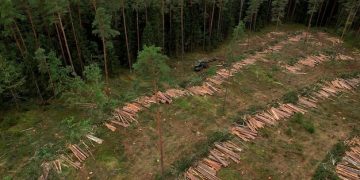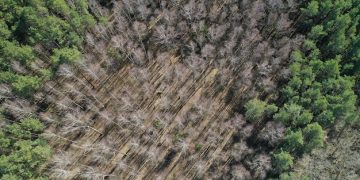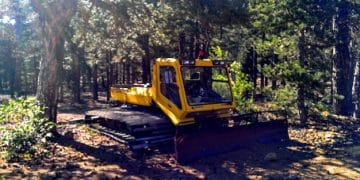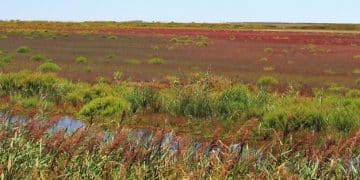Deforestation & Habitat Fragmentation: Impacts on US Wildlife

Deforestation and the fragmentation of habitats significantly impact US wildlife by reducing their living spaces, disrupting migration patterns, and increasing competition for resources, leading to declines in biodiversity and ecosystem health.
The United States is home to a diverse range of wildlife, from the majestic bald eagle to the elusive gray wolf. However, these creatures and their habitats are increasingly threatened by deforestation and the fragmentation of habitats: What’s the impact on US wildlife?
Understanding Deforestation and Habitat Fragmentation
Deforestation, the clearing of forests for other land uses, and habitat fragmentation, the breaking up of continuous habitats into smaller, isolated patches, are critical environmental issues that have far-reaching consequences for ecosystems and biodiversity.
What is Deforestation?
Deforestation involves removing or clearing forests for various purposes, including agriculture, urbanization, logging, and mining. The process often involves complete removal of trees and vegetation, leading to significant alterations in the landscape.
What is Habitat Fragmentation?
Habitat fragmentation occurs when large, continuous habitats are divided into smaller, isolated patches. This can happen naturally due to geological events or fires, but it’s increasingly caused by human activities such as road construction, urban development, and agricultural expansion.

Ultimately, deforestation and habitat fragmentation directly impact the ability of land to provide suitable homes for wildlife.
The Direct Impacts on US Wildlife Populations
The primary and most immediate impact of deforestation and habitat fragmentation on US wildlife populations is the loss or reduction of suitable habitats, directly threatening the survival and reproductive rates of numerous species.
- Loss of Breeding Grounds: Many species require specific habitats for breeding, nesting, and raising their young. Deforestation can eliminate these critical breeding grounds, leading to population declines.
- Reduced Food Availability: Forests provide a wide array of food sources for wildlife. Deforestation reduces the availability of fruits, nuts, insects, and other food items, impacting the nutritional health and survival of many species.
- Increased Competition: As habitats shrink, wildlife populations become concentrated in smaller areas, leading to increased competition for limited resources such as food, water, and shelter. This can stress individuals and reduce overall population health.
- Disrupted Migration Patterns: Habitat fragmentation creates barriers to migration, making it difficult for animals to move between seasonal habitats. This can disrupt breeding cycles, reduce genetic diversity, and increase the risk of local extinction.
These direct impacts not only threaten individual species, but also disrupt entire ecosystems, with far-reaching consequences for biodiversity and ecosystem stability.
Indirect Ecological Consequences
Beyond the immediate effects on habitat and species populations, deforestation and habitat fragmentation trigger a range of indirect ecological consequences that further destabilize ecosystems.
Edge Effects
Edge effects refer to changes in environmental conditions at the boundary between two habitats. When forests are fragmented, the increased edge area exposes remaining habitats to altered microclimates, increased sunlight, changes in humidity, and greater exposure to invasive species.
Altered Species Interactions
Habitat fragmentation can alter the interactions between species, leading to imbalances in food webs, predator-prey relationships, and pollination dynamics. For example, the loss of top predators can lead to overpopulation of prey species, resulting in excessive grazing and habitat degradation.
Decreased Biodiversity
Habitat fragmentation often leads to a decline in biodiversity, as specialized species that require large, continuous habitats are unable to survive in smaller, isolated patches. This loss of biodiversity can reduce ecosystem resilience and increase vulnerability to environmental changes.
The alteration of ecological balance will diminish the delicate harmony of the habitats involved.
Case Studies: Wildlife Species at Risk
Several US wildlife species are particularly vulnerable to the effects of deforestation and habitat fragmentation. Examining their situations provides insights into broader conservation challenges.
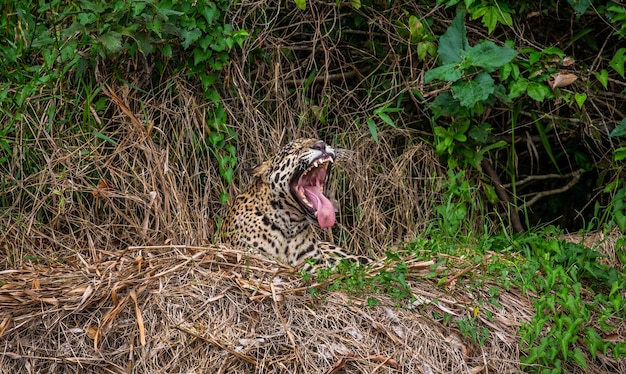
- Florida Panther: Habitat loss and fragmentation due to urbanization and agricultural expansion have reduced the Florida panther population to critically low levels. These panthers require large, connected habitats to roam, hunt, and breed.
- Northern Spotted Owl: The Northern Spotted Owl is threatened by logging of old-growth forests in the Pacific Northwest. Habitat fragmentation has reduced the owl’s nesting sites and hunting grounds, leading to significant population declines.
- Red-cockaded Woodpecker: The Red-cockaded Woodpecker is an endangered species that relies on mature pine forests in the Southeast. Deforestation and habitat fragmentation have reduced the availability of suitable nesting sites, impacting the woodpecker’s survival.
- American Pika: The American Pika, a small mammal inhabiting high-elevation areas in the western US, is threatened by climate change and habitat loss. As temperatures rise, pikas are forced to move to higher elevations, but habitat fragmentation limits their ability to disperse and find suitable habitats.
These stories not only highlight the plight of individual species, but it also underscores the potential for a total collapse of local ecosystems.
Mitigation Strategies and Conservation Efforts
Addressing the impacts of deforestation and habitat fragmentation requires comprehensive mitigation strategies and conservation efforts focused on preserving and restoring habitats, promoting sustainable land use practices, and increasing public awareness.
Habitat Preservation
Protecting existing forests and natural habitats is crucial for mitigating the impacts of deforestation. Establishing protected areas such as national parks, wildlife refuges, and conservation easements can safeguard critical habitats from development and deforestation.
Habitat Restoration
Restoring degraded habitats through reforestation, wetland restoration, and stream rehabilitation can improve habitat connectivity and support wildlife populations. Reforestation projects can re-establish forests in deforested areas, providing new habitats for wildlife. Wetland restoration can improve water quality, increase biodiversity, and provide critical habitats for migratory birds and aquatic species.
Sustainable Land Use Practices
Promoting sustainable land use practices in agriculture, forestry, and urban development can minimize the impacts of deforestation and habitat fragmentation. Implementing sustainable logging practices, such as selective harvesting and reduced-impact logging, can reduce the impact on forest ecosystems. Encouraging sustainable agriculture practices such as crop rotation, cover cropping, and conservation tillage can reduce soil erosion, improve water quality, and enhance wildlife habitats.
The proper planning of our communities will allow our society to thrive alongside wildlife.
The Role of Policy and Public Awareness
Effective policies and increased public awareness are essential for addressing the underlying drivers of deforestation and habitat fragmentation and promoting sustainable conservation practices.
Policy Measures
Implementing strong environmental regulations, land use planning policies, and conservation incentives can help reduce deforestation and habitat fragmentation. Zoning laws can restrict development in environmentally sensitive areas, while conservation easements can provide financial incentives for landowners to protect their land. Carbon pricing mechanisms can incentivize forest conservation and reduce emissions from deforestation.
Public Education and Engagement
Raising public awareness about the importance of forest conservation and biodiversity can promote responsible environmental stewardship. Educational programs, community outreach initiatives, and citizen science projects can engage individuals in conservation efforts and promote a greater understanding of the value of natural ecosystems.
By taking a responsible approach to our land, we can have communities that thrive with diverse ecosystems.
| Key Point | Brief Description |
|---|---|
| 🌳 Habitat Loss | Reduces living spaces for wildlife, threatening survival. |
| 🐾 Fragmentation Effects | Disrupts migration, limits genetic diversity. |
| 🛡️ Conservation | Habitat preservation and sustainable practices help. |
| 🌱 Policy & Awareness | Essential for long-term conservation efforts. |
Frequently Asked Questions
The primary causes of deforestation in the US include urbanization, agricultural expansion, logging, and mining activities, which clear forests for different land uses.
Habitat fragmentation creates barriers that disrupt migration patterns, making it difficult for animals to move between seasonal habitats and affecting breeding cycles.
Edge effects are changes in environmental conditions at the boundaries of fragmented habitats, leading to altered microclimates, increased sunlight, and greater exposure to invasive species.
Conservation strategies include habitat preservation, reforestation, sustainable land use practices, and strong environmental regulations to protect forests and wildlife.
Public awareness promotes responsible environmental stewardship by educating individuals about the value of natural ecosystems and engaging them in conservation efforts.
Conclusion
Deforestation and habitat fragmentation pose a significant threat to US wildlife, disrupting ecosystems and leading to a decline in biodiversity. Addressing these issues requires comprehensive mitigation strategies, robust policies, and increased public awareness to ensure the long-term health and sustainability of natural habitats.
